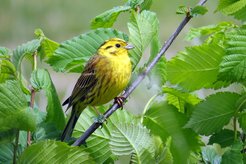Red List Breeding Birds: Bird deaths in Germany continue
Scientists and bird conservationists call for a national rescue plan to stem the dramatic decline in breeding birds
Along with climate change, species extinction is one of the greatest threats to life on earth. For about 50 years, researchers have been documenting the population trends of different animal and plant groups in so-called Red Lists. The new Red List of Breeding Birds in Germany shows that the decline of birds in Germany continues unabated. More than half of the 259 permanently breeding bird species are endangered. Fourteen species have become extinct in Germany so far, and 6 more will probably have to be listed as extinct in the next Red List of breeding birds. This means that breeding bird species are threatened with extinction on an unprecedented scale. Birds of the agricultural landscape as well as insectivores and migratory birds are most threatened. Birds living in forests or residential areas, on the other hand, are on the increase. Success stories for white storks, white-tailed eagles and cranes show that conservation measures can halt the decline of birds. The authors of the Red List therefore call for a national bird rescue program in which effective bird conservation measures are developed and implemented. In addition, the causes of the declines of the various species should be investigated through dedicated research.

In the future, the Red Lists will be published every six years. The Red List of Breeding Birds of Germany is a joint effort of the scientific ornithologists as well as national scientific institutions active in bird monitoring and bird conservation. The published Red List of Breeding Birds covers the period from 2011 to 2016.
The Slavonian Grebe, Golden Plover, Wood Sandpiper, Caspian Tern, Woodchat Shrike and Aquatic Warbler - anyone who wants to admire these birds in Germany is probably too late. The last breeding pairs were sighted in this country between 2009 and 2014. On the next Red List of Breeding Birds, these species are expected to be listed as extinct in Germany, in addition to the 14 species that are already extinct or missing. "This will be the highest increase of extinct breeding bird species ever recorded in Germany," says Hans-Günther Bauer of the Max Planck Institute for Animal Behavior in Radolfzell, one of the authors of the current Red List of Breeding Birds.
Almost half of the species are endangered
In the reporting period of the new Red List, 33 bird species in Germany are threatened with extinction, and populations are continuing to decline in almost all of them. At 43 percent, almost half of the species that regularly breed in Germany are endangered. Another eight percent are still comparatively common, but their numbers are also declining sharply. "The new Red List shows that species extinction in Germany continues unabated. It has even accelerated in recent years," says Bauer.
In addition, the Red List's threat categories do not reflect the decline of previously non-threatened and common species. Even huge losses of individuals can go unnoticed for a long time in the Red List for species such as starlings or house sparrows, if the species as such are still non-threatened. For example, a study from the Lake Constance region found that the area has lost 120,000 breeding pairs over the past 30 years. Germany-wide, the loss probably amounts to several million individuals.
According to the current Red List, species of the agricultural landscape are particularly threatened: 83 percent of these "open land" species show such high population declines that they are listed as endangered or on the early warning stage. Forty to 50 percent of insectivorous species are disproportionately affected by declines. Migratory birds are by far the hardest hit group, with over 50 percent of species listed as endangered or declining sharply. In contrast, many forest and urban species have increased in recent years – but whether this trend continues remains to be seen.
Sharp declines in open lands

The causes of the sharp decline in open-land species, insectivores, and migratory birds can be linked to intensive land use-especially agriculture-and overuse of pesticides, as well as hazards and habitat loss on migratory routes. For many species, however, the reasons are complex and sometimes poorly understood. "There's a lot of research that needs to be done. We want to fill some of these knowledge gaps with our new animal monitoring system Icarus. With it, we can literally look over the shoulders of birds in their natural environment and thus find out what threatens them," explains Martin Wikelski, director at the Max Planck Institute for Animal Behavior, who is studying the migratory behavior of blackbirds, cuckoos and storks, and other birds.
In addition to the sharp declines in most bird species, there are also individual bright spots: Where species and their habitat have been specifically protected, populations have recovered. Charismatic birds such as white-tailed eagles, ospreys, cranes and white storks, whose declines had clear and relatively easy-to-mitigate causes, have thus been saved from disappearing. "These examples show that measures to protect species and their habitats and thus protect biodiversity can be successful. What we need now is a national bird rescue program whose measures are actually implemented. Otherwise, we will have to say goodbye to many other bird species in Germany as well," Bauer warns.













